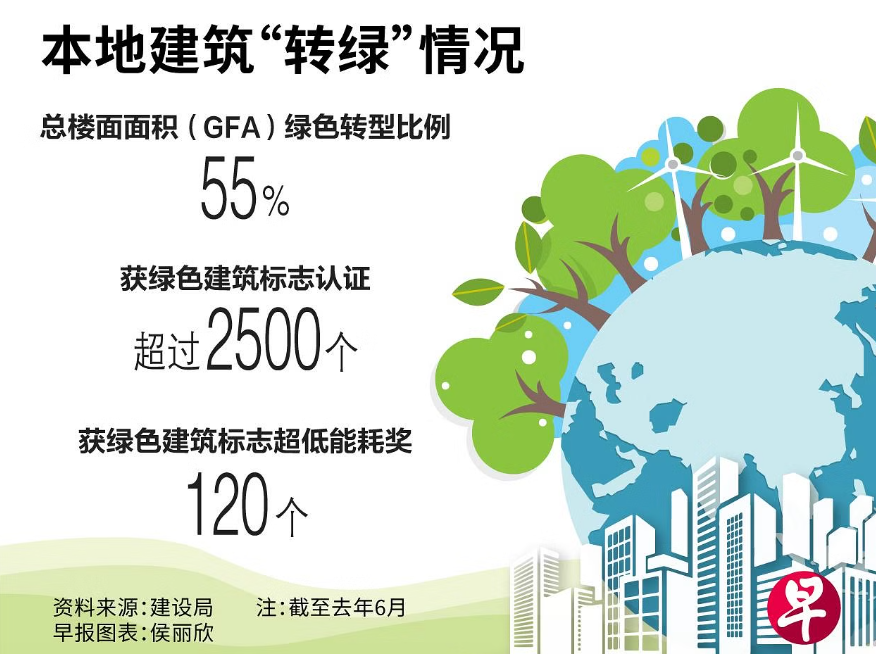Green financing to help local buildings low-carbon transition “zero investment”
By: Yue Kaixin
The total green building market in the Asia-Pacific region is worth about US$163.4 billion (about S$219.4 billion) up to 2022, according to a report by market research firm Market Research last June. (Photo by Yenyan Wang).
Singapore is committed to converting at least 80% of its buildings to low-carbon and environmentally friendly buildings by 2030. This commitment not only boosts local sustainability efforts but also encourages the adoption of innovative ‘green’ services. It’s worth noting that this green transformation of local buildings can be achieved through a “zero investment” approach.”
As implied by the term “zero investment,” the building owner incurs no upfront costs for enhancing the building’s sustainability. This investment is covered through green financing arranged by the energy efficiency solution provider, in collaboration with local financial institutions.
In an interview with Lianhe Zaobao, Jamie Lee (李洁敏), the Marketing and Communications Manager at Singaporean energy services company bbp, said that carbon emission reduction solutions need to be customized for each site to address the specific needs of different projects. Additionally, she noted that the scarcity of capital for these transitions has prevented many owners from committing to enhancing the sustainability of their buildings.
Bank Launches U-Energy Program to Solve Financing Problems for Green Transformation
Wong Song Ling (王松龄), Head of Strategic Planning for Real Estate and Infrastructure Industries at UOB, identified project scale and energy efficiency standards as key challenges in transforming local buildings into more sustainable structures. To address these financing hurdles, UOB introduced the U-Energy program, designed to facilitate the financial aspects of such transformations.
The “zero investment” model proposed by UOB not only addresses the cost concerns of building owners but also guarantees the effective execution of sustainability solutions. This is achieved through ongoing support and services provided by energy service companies post-transformation, ensuring a seamless transition to greener practices.
In the “Energy-as-a-Service” (EaaS) model, the energy service company not only finances and oversees the building transformation but also takes on the responsibility for subsequent equipment maintenance and tracking of energy performance. Building owners are required to enter into an EaaS contract, typically lasting between three to seven years, where a portion of the energy savings generated is shared as compensation to the energy service company. This approach simplifies the process for owners, who benefit from improved energy efficiency without the need for upfront investment or ongoing maintenance concerns.
Jamie also revealed that more than 80% of bbp’s projects are operated through the “zero investment” model. As of January this year, the company has helped its customers save a total of 480 million kilowatt hours (kWh) of electricity, equivalent to 120 million yuan in energy bills, while reducing greenhouse gas emissions (CO2e)by 240 million kg.
Wong Song Ling noted that the U-Energy program supports building owners in executing energy conservation strategies across eight critical areas, including indoor cooling, as well as energy and power management.
As of last September, the U-Energy program had achieved an annual energy savings of 51 gigawatt-hours (GWh), equivalent to a reduction of about 25,000 metric tons of carbon dioxide emissions. This reduction is comparable to eliminating 6,000 vehicles from the roads each year, demonstrating the program’s substantial contribution to reducing environmental impact.
Government Funding Boosts Energy Transformation in Singapore Buildings
Beyond the contributions of financial institutions and energy service companies, the government has been actively promoting and providing subsidies for the energy transition in local buildings over recent years.
Hong Jian Sheng, Senior Director of Building and Construction Authority, mentioned that to assist building owners in improving their energy efficiency, BCA introduced the $63 million Green Mark Incentive Scheme for Existing Buildings 2.0 (GMIS-EB) in late June 2022. This scheme offers subsidies to support building owners in undertaking energy efficiency projects, partially covering the costs associated with the green transformation.
The incentive provided by the scheme varies depending on the Green Mark certification level achieved and the amount of carbon emissions reduced. For instance, a project that attains a Green Mark Zero Energy (ZE) Energy rating and successfully reduces carbon dioxide emissions by 1,000 metric tons would be eligible for a grant of $45,000, dependent on the progress of the Energy Improvement Works (EIWs).
More than 2,500 buildings certified with green mark
Hong reported that by the end of June last year, about 55 percent of the Singapore’s total floor area had undergone green transformations, resulting in more than 2,500 buildings receiving the Green Mark Label. Following the launch of the ultra-low-energy building program in 2018, there has been a noticeable increase in buildings achieving higher green standards. Out of the 120 local buildings that have been honored with the Green Mark Super Low Energy award by the Construction Authority, 79 received their awards in the last three years alone.
The green building market in the Asia-Pacific region has seen rapid expansion recently. A June report from Market Research revealed that by 2022, the total value of the green building market in Asia-Pacific reached approximately US$163.4 billion (about S$219.4 billion), growing at a compound annual growth rate (CAGR) of 5.7% from 2017 to 2022. This growth underscores the increasing significance of green buildings in the region.
Jamie highlighted that the surge in Asia’s green building market is propelled by factors such as rapid urbanization, heightened environmental consciousness, and supportive government policies. The focus of market development now includes the integration of renewable energy, sustainable urban planning and development, and the optimization of energy efficiency technology.
岳开新
根据市场研究机构Market Research去年6月的报告,截至2022年,亚太地区的绿色建筑市场总价值约为1634亿美元(约2194亿新元)。(王彦燕摄)
我国致力在2030年将至少八成建筑转为低碳环保建筑。这不仅会提高本地可持续发展水平,也促进“绿色”创新服务。一些人也许还不知道,本地建筑绿色转型可以“零投资”完成。
顾名思义,“零投资”即业主无须负担建筑绿色转型的初始投资,这部分资金由节能方案供应商与本地金融机构联手,通过绿色融资方式解决。
本地能源服务公司bbp营销和传播经理李洁敏接受《联合早报》采访时说,在本地建筑绿色转型挑战中,除了项目差异使减碳解决方案须因地制宜外,缺乏转型资金也曾让许多业主望而却步。
银行推出U-Energy计划 为转型解决融资问题
大华银行房地产及基础设施产业策略规划部主管王松龄指出,项目规模和节能标准是本地建筑转型遇到的主要问题,为此,银行推出了U-Energy计划,为转型解决融资问题。
其实,“零投资”模式不仅解决了业主成本问题,能源服务公司在转型后的跟进服务,也保证解决方案能有效实施。
在这个模式下,能源服务公司除了承担融资和建筑改造方案外,还负责后期设备维护及能源绩效追踪,业主只需要签署一份为期三年至七年的“能源即服务”(Energy-as-a-Service,EaaS)合同,将部分能源节约资金作为对能源服务公司的回报。
李洁敏透露,他们公司有超过八成的项目通过“零投资”模式运作。截至今年1月,公司已帮助客户累计节省了480吉瓦时(GWh)电力,相当于1亿2000万元能源费,同时减少了24万公吨的温室气体排放。
王松龄说,U-Energy计划可帮助建筑业主在室内制冷、能源消耗和电力管理等八个方面实施节能举措。
截至去年9月,U-Energy计划每年节省51吉瓦时(GWh)能源,相当于减少约2万5000公吨二氧化碳排放。减少的排放相当于每年减少6000辆汽车。
政府大力推广资助本地建筑能源转型
除金融机构和能源服务公司外,政府近几年也大力推广并资助本地建筑能源转型。
建设局可持续环境发展署高级署长洪建生说,为帮助业主提升建筑节能水平,建设局2022年6月底推出6300万元的绿色建筑奖励计划(现有建筑) 2.0(Green Mark Incentive Scheme for Existing Buildings 2.0,简称GMIS-EB 2.0),用于资助业主绿色转型的部分成本。
这项奖励计划以绿色建筑标志认证等级和碳排放减少程度为基础。例如,达到绿色建筑标志零能耗等级并减少1000公吨二氧化碳排量的项目,可根据节能改造工程(Energy Improvement Works,简称EIWs)完成进度,获得4万5000元的资助。
超过2500个建筑获绿色建筑标志认证

洪建生说,截至去年6月底,全岛近55%的总楼面面积已实现绿色转型。超过2500个建筑获得了绿色建筑标志认证。自2018年实施超低能耗建筑计划以来,越来越多的建筑获得了更高标准的绿色认证。本地120个获得建设局颁发绿色建筑标志超低能耗奖(Green Mark Super Low Energy)的建筑中,79个是过去三年中颁发的。
近几年,亚太绿色建筑市场增长迅速。根据市场研究机构Market Research去年6月的报告,截至2022年,亚太地区的绿色建筑市场总价值约为1634亿美元(约2194亿新元)。市场从2017年至2022年期间的复合年增长率为5.7%。这表明人们对绿色建筑的重视程度不断提高。
李洁敏说,在城市化进程加快、环保意识增强及政府扶持政策的推动下,亚洲绿色建筑市场发展迅猛。可再生能源整合、可持续城市规划发展和能效优化技术已成为市场发展的焦点。
